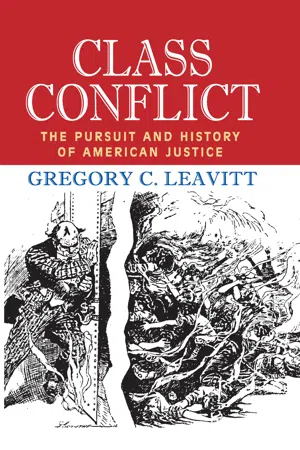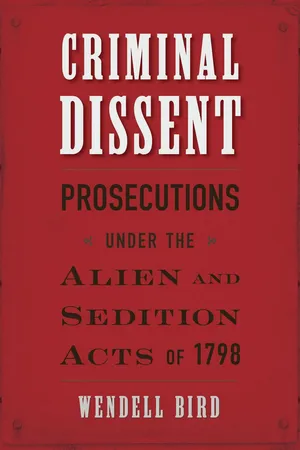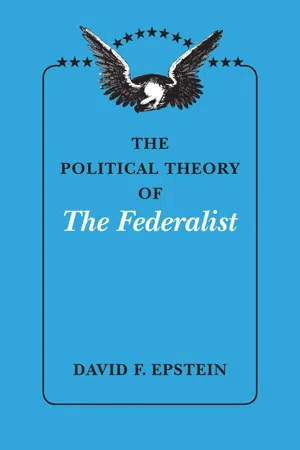Federalist vs Anti Federalist
The Federalists and Anti-Federalists were two opposing political factions during the early years of the United States. The Federalists, led by Alexander Hamilton and John Adams, supported a strong central government and the ratification of the Constitution. In contrast, the Anti-Federalists, including Thomas Jefferson and Patrick Henry, were concerned about the potential for centralized power and advocated for states' rights and a more limited federal government.
5 Key excerpts on "Federalist vs Anti Federalist"
- eBook - ePub
Class Conflict
The Pursuit and History of American Justice
- Gregory C. Leavitt, Gregory C. Leavitt(Authors)
- 2017(Publication Date)
- Routledge(Publisher)
...People who had known one another their whole lives now crossed streets to avoid confrontations. Personal differences easily spilled into violence, and fighting erupted in the state legislatures and even in the federal Congress” (Wood 2009:209). This animosity was not purely class conflict, but class conflict was certainly a major underlying factor. As seen, the Federalists wanted to maintain an elitist and wealth-dominated polity whereas the Democratic-Republicans, especially the northern Republicans, wanted a “citizens’” republic with liberty, equality, and justice broadly extended. The Democratic-Republican Party: Jeffersonian and Madisonian Democracy As political parties began to form in 1791, Jefferson and Madison seemed unlikely figures as the first choice to lead common, middle-class, and Antifederalist Americans who were wary of the Federalist gentry and their aristocratic airs. Once the Constitution was passed other issues came to the fore and “by early 1791 the press boiled with talk of the dangers of monarchy and monocrats—talk that resonated well beyond the world of the Southern planters concerned with slavery: many Northern middling sorts were also anxious about the dangers of monarchy and the kind of aristocratic society that accompanied it” (Wood 2009:146). This made for strange bedfellows but both southern plantation owners and the northern middle class were concerned about the appearance of a strong centralized government represented by the Federalists, though for different reasons. Southern growers worried that Federalism threatened the southern agricultural economy and the institution of slavery, whereas common and middle-class northern Americans worried that Federalism threatened democracy, which they felt was synonymous with local rule. With Hamilton’s proposed national bank, opposition to Federalism, and the strong centralized government it represented “assumed a more strident and ideological character. . . ...
- eBook - ePub
- Gregory Claeys(Author)
- 2013(Publication Date)
- CQ Press(Publisher)
...Perhaps the best evidence that the framers’ collective intent is altered in the essays are the views on the role of government by Hamilton and Madison themselves. After ratification, Hamilton and Madison developed a sharp disagreement on the meaning of the Constitution, with Hamilton remaining a Federalist and Madison becoming a Republican—the political party started by Madison and Jefferson that reflected the sentiments of the anti-federalists, defending states’ rights and rejecting federalist policies such as Treasury Secretary Alexander Hamilton’s proposed new national bank. Regardless of whether or not the arguments found in the Federalist Papers can be attributed to an overarching viewpoint developed at the Constitutional Convention, the essays have profoundly influenced the study of American politics. The Federalist is widely admired and studied. Both philosophical and practical in nature, it is even more grounded in the reality of the times than other works examining the purpose of government, such as John Locke’s Second Treatise of Government or Baron de Montesquieu’s Spirit of the Laws. Further, The Federalist did not need time for the public to recognize its value. Within a year of the drafting of the Constitution, the Federalist Papers were understood to be a guide to explain the necessity of each clause proposed in the Constitution. The essays that make up The Federalist are often read individually for their insight into such issues as federalism, the separation of powers, the need for a strong national government, and judicial review, but when considered in its entirety, The Federalist ranks just after the Declaration of Independence and the Constitution itself as explanations for the eventual shape of politics and institutions in the United States...
- eBook - ePub
Criminal Dissent
Prosecutions under the Alien and Sedition Acts of 1798
- Wendell Bird(Author)
- 2020(Publication Date)
- Harvard University Press(Publisher)
...Federalists were the administration, filling nearly all political offices in the new federal government, and they readily characterized disparagement of any official as disparagement of the government. In Cooper’s words, Federalists “condemn as enemies of the one [the government], all who may disapprove of the measures of the other [the executive officers],” while Republicans believe “that a sincere friend to the Constitution and the Country, may sometimes disapprove the opinions and measures of the officers of Government.” From a Federalist standpoint, it was easy to view criticism as criminal defamation or sedition, the product of illegitimate factions and parties. The danger of factions and political parties was a point of agreement when the Constitution was ratified. Factions and parties served private interests, while enlightened officials should serve the national interest; and factions and parties were accompanied by corruption as English parties showed. The key point on which Federalists and Republicans differed was which one of them was a faction or an incipient party. A dozen essays in The Federalist had denounced factions and parties. Washington’s Farewell Address had warned of “the baneful effects of the spirit of party” and faction. Adams’s inaugural speech condemned “the danger to our liberties” from parties determining elections or administrations. Consequently, people referred to their own side as the “Federalist interest” or the “Republican interest” in the early 1790s—not as parties—while they reprehended the other side as a faction or party. 19 A related fundamental difference between most Federalists and most Republicans, at least once most Federalists shifted as the Alien and Sedition Acts were passed in mid-1798, was their views of freedom of speech and press, particularly about officials and government...
- eBook - ePub
Revolutionary America, 1763-1815
A Sourcebook
- Francis D. Cogliano, Kirsten E. Phimister, Francis D. Cogliano, Kirsten E. Phimister(Authors)
- 2010(Publication Date)
- Routledge(Publisher)
...Much of the strength & efficiency of any Government in procuring and securing happiness to the people, depends on opinion, on the general opinion of the goodness of the Government, as well as well as of the wisdom and integrity of its Governors. I hope therefore that for our own sakes as a part of the people, and for the sake of posterity, we shall act heartily and unanimously in recommending this Constitution (if approved by Congress & confirmed by the Conventions) wherever our influence may extend, and turn our future thoughts & endeavors to the means of having it well administered. On the whole, Sir, I cannot help expressing a wish that every member of the Convention who may still have objections to it, would with me, on this occasion doubt a little of his own infallibility—and to make manifest our unanimity, put his name to this instrument.”—He then moved that the Constitution be signed by the members and offered the following as a convenient form viz. “Done in Convention, by the unanimous consent of the States present the 17th. of Sepr. &c—In Witness whereof we have hereunto subscribed our names.” 5. Federalist Number 10 5 In the debate over the ratification of the Constitution, Federalists and Antifederalists produced hundreds of essays which appeared in newspapers and pamphlets. Among these, the most famous are the eighty-five Federalist essays which appeared in New York newspapers between October 1787 and August 1788. The essays, published under the pseudonym “Publius,” were written by James Madison, Alexander Hamilton, and John Jay. Madison wrote twenty-seven essays, Hamilton fift y-one, and Jay five. Taken together, they constitute the most coherent explication of the Federalist principles during the ratification debate. Federalist No. 10 is, perhaps, the most famous of the essays. In it, Madison addressed the widespread belief, derived from Montesquieu’s Spirit of the Laws, that republics must be geographically small to thrive...
- eBook - ePub
- David F. Epstein(Author)
- 2008(Publication Date)
- University of Chicago Press(Publisher)
...Except insofar as the states will be controlled or replaced by the central government, they will remain defective, small republics. That is why Madison proposed to the Constitutional Convention that the national legislature be given a veto over state acts; and it was in support of that proposal that Madison presented the arguments of Federalist 10. While Madison feared that the constitutional prohibitions on states (e.g., regarding ex postfacto laws, and paper money) and federal judicial review of state acts would be inadequate substitutes for his proposal, the case Federalist 10 makes for an extended republic applies to America only if the central government becomes the essential political arena—or if (as Federalist 56 suggests) future developments diversify the states themselves, making them more like large republics. 110 (4)While Hume suggests that his plan will reduce the opportunity for the success of malign proposals, he does not argue as Madison does that national diversity will make a similar impulse less likely in the majority. This principle could have been suggested to Madison by various political experiences. In Federalist 51 ’s recapitulation of Federalist 10’s argument, Madison notes that a “multiplicity of sects” is a security for “religious rights” (51, p. 324). In his earlier career, Madison was a leader in a fight in Virginia against state-established religion; and he noted in a letter to Jefferson that the hatred between Presbyterians and Episcopalians had prevented their acting as a coalition against religious liberty. 111 Madison also saw the effects of diversity in the American confederacy of the 1780s, which was often unable to agree. The seeds of the extended-sphere argument are visible in a letter Madison wrote to Lafayette in 1785...




